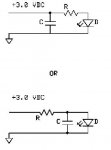Umm, I don't really know what you all are saying^^, but basically, YES you can use just a resistor in series with a red LD using the circuit driver inside the Dorcy Jr. As Kenom said, he's done it as well as many/some other members on the forum (including myself). I was also cheap, and mine's been holding up fine for months now. However, I'm not sure quite how you would build one without a heatsink. Jake21 (not really a member here anymore) built my heatsink for $10. But, if you plan on going without a heatsink, you should at LEAST try to use a washer or two. Just drill out the inside of the washer to fit the aixiz module inside. Then grind away the outside of the washer until it fits inside the host. Basically, you can do it and build it for cheap. Also, MAKE SURE YOU DO NOT USE A 3.6/3.7V RCR123a BATTERY WITH IT. ONLY A 3V Primary (non-rechargeable), or 3V rechargeable (DX has one pair of 3V RCR123a - I personally use that with my Dorcy). And, I believe they said a 5ohm resistor is ideal, but I think I personally used 4.7ohm or something (don't remember exactly). And, I used a closed can diode, not an open can... but really there is not too big of a difference. However, I believe people said a closed can (normally in a DVD burner), is better to use than the open can, when doing this Dorcy build.




